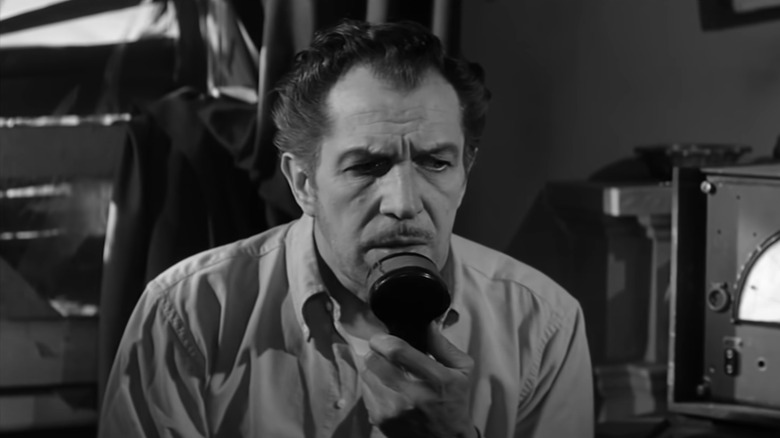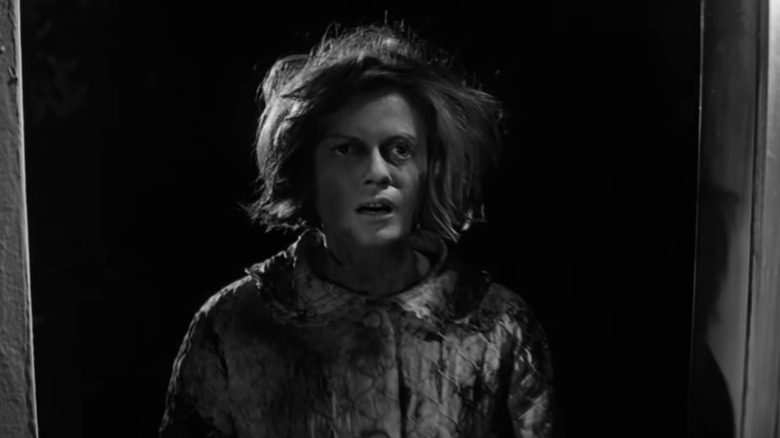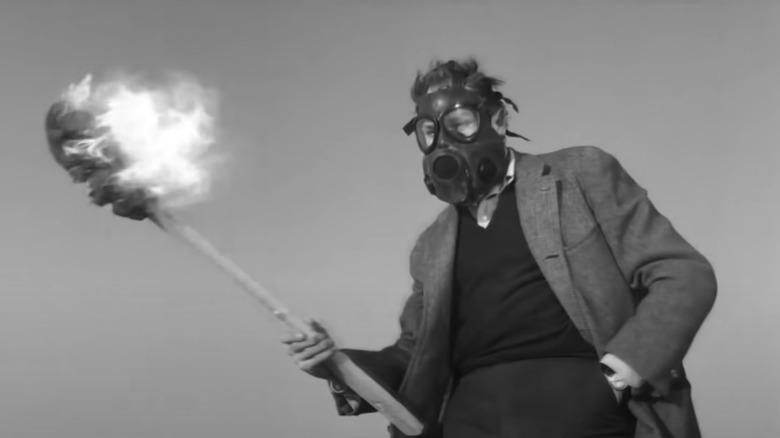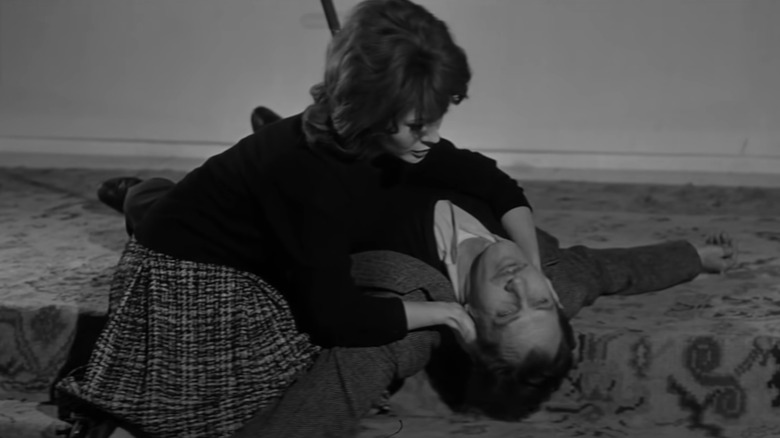Year Of The Vampire: The Last Man On Earth Was The Vampire Gateway To The Zombie Apocalypse
(Welcome to Year of the Vampire, a series examining the greatest, strangest, and sometimes overlooked vampire movies of all time in honor of "Nosferatu," which turns 100 this year.)
"The Last Man on Earth," the first film adaptation of Richard Matheson's watershed 1954 vampire novel, "I Am Legend," has the feel of a midnight movie, something you'd maybe catch on TV in letterboxed form back when AMC still trafficked more in "American Movie Classics" than hour-long dramas like "The Walking Dead." Whether it be the out-of-sync dubbing of this Italian co-production, the surreal black-and-white image of a character donning a gas mask and throwing vampire bodies in a burning pit, or just the presence of Vincent Price — an actor who worked with B-movie master Roger Corman on a number of Edgar Allen Poe adaptations — "The Last Man on Earth" has all the ingredients of a '60s cult classic.
Matheson's book was one of the most influential works in the development of both the vampire and zombie genre. It served as the inspiration for George Romero's 1968 film, "Night of the Living Dead," which brought the modern zombie to life as an entity distinct from the Haitian sugar-mill workers controlled by Bela Lugosi's character in "White Zombie" in 1932. This, in turn, paved the way for the aforementioned "Walking Dead" and a legion of other post-apocalyptic zombie tales on celluloid.
Directed by Sidney Salkow and Ubaldo B. Ragona, "The Last Man on Earth" and its 1964 vampire apocalypse preceded "Night of the Living Dead" by four years. As Price's weary protagonist, Robert Morgan, moves through a world where civilization has crumbled and bodies are strewn everywhere, the slow-moving, plank-wielding vampire hordes that mob him exist as clear precursors to Romero's "ghouls," as he originally called them. Like "Night of the Living Dead," this film is also in the public domain and freely available to view on YouTube or the Wikimedia Commons.
What it brought to the genre
Within the vampire genre, "The Last Man on Earth" was instrumental in creating a more scientific framework for future stories where crucifixes and holy water were no longer effective against vampires except perhaps as psychosomatic weapons. Matheson's book laid the groundwork for a more relativistic undead landscape, stating outright that if they became a vampire, "neither a Jew nor a Hindu nor a Mohammedan nor an atheist, for that matter, would fear the cross." The horror film was a stepping stone away from Gothic superstitions toward a more pseudo-realistic vision of vampires. You can trace a line from this film to 21st-century titles like Guillermo del Toro and Chuck Hogan's "The Strain." "The Last Man on Earth" still features the classic ideas — like references to crosses — but it reimagines its central character as a scientist, ready to carry out blood transfusions and examine the vampire plague via microscope.
While contemporary viewers may know the title "I Am Legend" from the 2007 Will Smith movie of that name, it is actually the third adaptation of Matheson's book, and a loose one, at that. Save for their aversion to sunlight, the film's much-maligned CG monsters — the bestial, non-verbal Darkseekers — bear little resemblance to Matheson's vampires, which are capable of speech. Likewise, the previous 1971 adaptation "The Omega Man," led by Charlton Heston, had similarly shifted the monsters away from their vampire roots into the realm of mutant albinos.
In the original adaptation, "The Last Man on Earth," the story is still wedded to classic vampire tropes like mirrors, garlic, and wooden stakes through the heart. There are some differences, but the core concept of a vampire-plague apocalypse is faithful to the original. This is a true vampire movie, but it's one that puts its own twist on things. Morgan, for instance, uses a mirror as a kind of shield or deflector to plow through a crowd of bloodsuckers on his way home. When he makes the mistake of burying his wife, Virg (Emma Danieli), without burning her first — ignoring the advice of authorities — she shows up on his doorstep and doesn't need an invitation to come in. The story has its own rules for vampirism, and that's part of the movie's appeal.
The vampire pandemic
The very premise of "The Last Man on Earth" mirrors our own real-world pandemic over the last two years, and certain lines of dialogue and plot elements feed into that. When characters talk about a "disease carried on the wind," or say, "I wish somebody would find a vaccine," it harkens back to the early days of COVID-19. The desire to find a cure and return to society certainly feels prescient; like many of us over the pandemic, Morgan struggles with isolation and loneliness. He cracks up while watching old home movies, first laughing, then crying. When he adopts a stray dog, he tells it, "We're going to have lots of happy times together," but shortly thereafter, he examines its blood, realizes it's infected, and is left hopeless again. Despite having debuted in 1964, "The Last Man on Earth" feels uniquely relatable in 2022.
Like COVID-19, the plague in "The Last Man on Earth" has physical signs of infection. Instead of losing their sense of taste or smell, victims in "The Last Man on Earth" lose their sense of sight. It's interesting that blindness is one of the early symptoms of vampirism here, given the racial overtones of some of Neville's book musings. In one infamous passage, Neville, a man "born of English-German stock," plays devil's advocate for the vampires in his own head, talking about how they are the victims of "unkind prejudice" and "thoughtless bias," how they have "no means of support, no measures for proper education," nor "the voting franchise." But then he undermines all of this with the thought, "Sure, sure ... but would you let your sister marry one?"
Not everything in "The Last Man on Earth" works; the story falters when it dips into an extended flashback sequence, only to come back out the other side of it and show Morgan still standing there in the same spot. Moments like this give the film a rather inert quality at times. The vampires aren't particularly scary, either — they just sort of flail about. However, once you get past such flaws, this is a film that was ahead of its time and is still worth revisiting for its historical value. In some ways, it did a better job of preserving Matheson's ideas than either of the two subsequent adaptations.
The vampire hunter as monster
When it's just Morgan on his own in "The Last Man on Earth," the audience shares his human perspective and defaults to him as the hero, but this is complicated by the arrival of another survivor, Ruth (Franca Bettoia). Her fearful interactions with him as he chases her down and menaces her with garlic bring out visible flaws in Morgan — which leads into a finale that challenges the audience's perspective.
In Ruth, we see the possibility that not all vampires are beyond redemption. Morgan theorizes that he himself developed immunity to the vampire plague after being bitten by a bat in Central America (Morbius, is that you?), but this makes him an anomaly among humans. Yet, Ruth and her kind are able to keep their symptoms in check with a vaccine. They plan to rebuild society — but because Morgan has no need of the vaccine, he regards them all as monstrosities in need of a cure that only his blood can provide. Even Morgan's onetime best friend and fellow scientist, Ben (Giacomo Rossi-Stuart), is unworthy of his mercy. As Morgan tells Ruth, "When I find [Ben], I'll drive a stake through him just like all the others." He has gone about slaying vampires indiscriminately, but Ruth points out to him, "Many of the people you destroyed were still alive."
The hunter soon becomes the hunted. Surrounded in a church by vampire families, Morgan calls them freaks and mutations, and it's plain to see that he is now the monster or titular "legend," deserving of being speared through the heart on the altar. The movie ends with Ruth soothing an infected child with the words, "There's nothing to cry about. We're all safe now." With Morgan dead, the vampires have won — and for them, it's a happy ending.
Despite multiple adaptations, it feels as though Matheson's novel, "I Am Legend," has never received the movie treatment it deserved. "The Last Man on Earth" is probably the most faithful of the three adaptations, perhaps because Matheson himself wrote the screenplay for it before having his name removed in favor of the pseudonym "Logan Swanson." While William F. Leicester took over the English version of the script and Matheson may not have been happy with the resulting film, "The Last Man on Earth" made its mark on vampire movie history and a whole lot of zombies probably owe their existence to it, as well.



